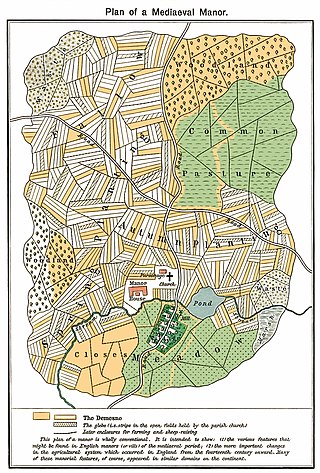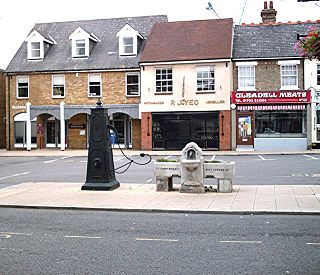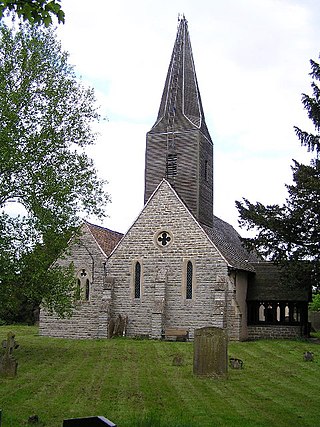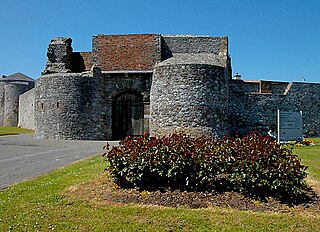Related Research Articles

Copyhold was a form of customary land ownership common from the Late Middle Ages into modern times in England. The name for this type of land tenure is derived from the act of giving a copy of the relevant title deed that is recorded in the manorial court roll to the tenant; not the actual land deed itself. The legal owner of the manor land remained the mesne lord, who was legally the copyholder, according to the titles and customs written down in the manorial roll. In return for being given land, a copyhold tenant was required to carry out specific manorial duties or services. The specific rights and duties of copyhold tenants varied greatly from one manor to another and many were established by custom. By the 19th century, many customary duties had been replaced with the payment of rent.

The open-field system was the prevalent agricultural system in much of Europe during the Middle Ages and lasted into the 20th century in Russia, Iran, and Turkey. Each manor or village had two or three large fields, usually several hundred acres each, which were divided into many narrow strips of land. The strips or selions were cultivated by peasants, often called tenants or serfs. The holdings of a manor also included woodland and pasture areas for common usage and fields belonging to the lord of the manor and the religious authorities, usually Roman Catholics in medieval Western Europe. The farmers customarily lived in separate houses in a nucleated village with a much larger manor house and church nearby. The open-field system necessitated co-operation among the residents of the manor.

The manorial system of New France, known as the seigneurial system, was the semi-feudal system of land tenure used in the North American French colonial empire. Economic historians have attributed the wealth gap between Quebec and other parts of Canada in the 19th and early 20th century to the persistent adverse impact of the seigneurial system.

Rochford is a town and civil parish in the Rochford District in Essex, England, 3 miles (4.8 km) north of Southend-on-Sea, 43 miles (69 km) from London and 21 miles (34 km) from Chelmsford. At the 2011 census, the civil parish had a population of 8,471.

Lord of the manor is a title that, in Anglo-Saxon England and Norman England, referred to the landholder of a rural estate. The titles date to the English feudal system. The lord enjoyed manorial rights as well as seignory, the right to grant or draw benefit from the estate. The title continues in modern England and Wales as a legally recognised form of property that can be held independently of its historical rights. It may belong entirely to one person or be a moiety shared with other people. The title is known as Breyr in Welsh.

Sir Thomas de Littleton or de LyttletonKBSL(c. 1407–23 August 1481) was an English judge, undersheriff, Lord of Tixall Manor, and legal writer from the Lyttelton family. He was also made a Knight of the Bath by King Edward IV.

A manor house was historically the main residence of the lord of the manor. The house formed the administrative centre of a manor in the European feudal system; within its great hall were usually held the lord's manorial courts, communal meals with manorial tenants and great banquets. The term is today loosely applied to various English country houses, mostly at the smaller end of the spectrum, sometimes dating from the Late Middle Ages, which currently or formerly house the landed gentry.

The Anti-Rent War was a tenants' revolt in upstate New York between 1839 and 1845. The Anti-Renters declared their independence from the manor system run by patroons, resisting tax collectors and successfully demanding land reform. The conflict resulted in the passage of laws that made feudal tenures illegal and outlawed leases greater than 12 years.

A demesne or domain was all the land retained and managed by a lord of the manor under the feudal system for his own use, occupation, or support. This distinguished it from land sub-enfeoffed by him to others as sub-tenants. In contrast, the entire territory controlled by a monarch both directly and indirectly via their tenant lords would typically be referred to as their realm. The concept originated in the Kingdom of France and found its way to foreign lands influenced by it or its fiefdoms.
Advowson or patronage is the right in English law of a patron (avowee) to present to the diocesan bishop a nominee for appointment to a vacant ecclesiastical benefice or church living, a process known as presentation.
In English law, seignory or seigniory, spelled signiory in Early Modern English, is the lordship (authority) remaining to a grantor after the grant of an estate in fee simple.

White Ladies Aston is a village in the Wychavon local government district of Worcestershire, England, United Kingdom, and also lends its name to the civil parish in which the village is located. The village is located to the east of the A44 which started as a Saltway linking Droitwich to Oxford. To the south is Pershore and five miles west is Worcester. The parish is bound to the east by the Bow Brook. The parish, according to the 2011 census, has 87 households with 220 residents.

Headley is a village and civil parish in the North Downs in Surrey, England. The nearest settlements are, to the west, Mickleham and Leatherhead; to the north, Ashtead and Langley Vale; to the east, Walton-on-the-Hill; and to the south, Box Hill. It is just outside the M25 motorway encircling London.

The manorial courts were the lowest courts of law in England during the feudal period. They had a civil jurisdiction limited both in subject matter and geography. They dealt with matters over which the lord of the manor had jurisdiction, primarily torts, local contracts and land tenure, and their powers only extended to those who lived within the lands of the manor: the demesne and such lands as the lord had enfeoffed to others, and to those who held land therein. Historians have divided manorial courts into those that were primarily seignorial – based on feudal responsibilities – and those based on separate delegation of authority from the monarch. There were three types of manorial court: the court of the honour; the court baron; and the court customary, also known as the halmote court.
The history of English land law can be traced back to Roman times. Throughout the Early Middle Ages, where England came under rule of post-Roman chieftains and Anglo-Saxon monarchs, land was the dominant source of personal wealth. English land law transformed further from the Anglo-Saxon days, particularly during the post-Norman Invasion feudal encastellation and the Industrial Revolution. As the political power of the landed aristocracy diminished and modern legislation increasingly made land a social form of wealth, subject to extensive social regulation such as for housing, national parks and agriculture.
An Inquisition post mortem is an English medieval or early modern record of the death, estate and heir of one of the king's tenants-in-chief, made for royal fiscal purposes. The process of making such inquisition was effected by the royal escheators in each county where the deceased held land. The earliest inq.p.m. was made in 1236, in the reign of King Henry III (1216–1272), and the practice ceased c. 1640, at the start of the English Civil War, and was finally abolished by the Tenures Abolition Act 1660, which ended the feudal system.
Guildable Manor is a Court Leet in Southwark under the authority of the City of London, along with the King's Manor, Southwark, and the Great Liberty. The name of 'Guildable' first recorded in 1377 refers to the collection of taxes there and was adopted to distinguish this from the other manors of the Southwark area. Its legal title, according to a Royal charter granted to the City by King Edward III in 1327, is 'the ville of Southwark' i.e. 'ville = 'town'; in the more substantive charter of Edward VI it is designated 'The Town and Borough of Southwark' as is stated on its Seal. It is a preserved limited jurisdiction under the Administration of Justice Act 1977. Although neither a guild nor a livery company, the Guildable Manor does have a permanent organization, consisting of Officers and Jurors.

The Philipse Patent was a British royal patent for a large tract of land on the east bank of the Hudson River about 50 miles north of New York City. It was purchased in 1697 by Adolphus Philipse, a wealthy landowner of Dutch descent in the Province of New York, and in time became today's Putnam County.

Sir Walter de la Haye, or de Haye was an English-born statesman and judge in Ireland of the late thirteenth and early fourteenth centuries, who served for many years as Sheriff of County Waterford and as Chief Escheator of Ireland, and briefly as Justiciar of Ireland.